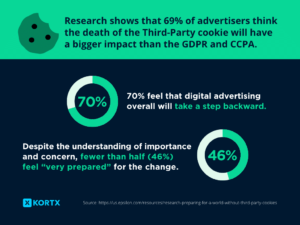If there’s one certainty about the digital advertising landscape, it’s that the only certainty is change.
Next on the docket: Google’s deprecation of third-party cookies.
For almost thirty years, third-party cookies have been an integral part of the digital ecosystem. Sure, these third-party cookies can be used to track your activities across websites, but many businesses use them to make your web experience greater – these can include helping you sign in or showing ads that make sense for you. Nonetheless, all of this is (eventually) coming to an end – primarily due to growing privacy concerns and stricter regulations like GDPR and CCPA/CPRA, which are forcing the phase-out of third-party cookies. That said, the deprecation timeline is still uncertain, but here’s where it stands today:
- January 4, 2024: Google disabled third-party cookies for 1% of Chrome users worldwide.
- June 30, 2024: Feedback on Google’s Privacy Sandbox tests due to the UK’s Competition and Markets Authority (CMA).
- June 30, 2024: The grace period for Chrome’s third-party cookie deprecation trials ends. (This only applies to organizations that have identified user-facing breakage through testing. This could be postponed as well.)
- Q1-Q2 2025: Google begins to deprecate all third-party cookies in Chrome, subject to Google resolving any remaining concerns with the CMA.
So, what does Google’s deprecation of third-party cookies mean for your brand? To be prepared for a cookieless future, your business needs to recalibrate your first-party data approach, identify alternative targeting tactics in place of cookie-based solutions, and reevaluate measurement strategies.

Recalibrate Your First-Party Data Strategy
“Nearly half (49%) of advertisers worldwide believe that activating their own first-party data is the most promising solution to cookie deprecation”, according to eMarketer. As such, one of the first questions you should be asking yourself is if you are blessed with data or if you are less with data.
If it’s the latter, your focus should be on augmenting your first-party data. Ramey recommends looking to customer surveys, app users, customer service interactions, customer feedback, lead gen campaigns, CRM databases, first-party pixel/website visitors, email and newsletter subscriptions, and even partnering with data-blessed companies, among others to bolster your first-party data generation strategy. However, recalibrating your first-party data strategy doesn’t end with the generation of said data, but is enriched with the ongoing analysis, and segmentation of first-party data to ensure it’s working as hard as possible for your business. Ultimately, no data is better than bad data.
To read more about a cookie-less future, sign up here to receive more insights.


